Wondering if Artex is right for your ceiling? You’re in the right place.
In this article, I’ll explain everything you need to know about Artex ceilings—what they are, how they look, and whether they make sense for your home.
Many homeowners struggle with ceiling decisions. The options can feel overwhelming. I understand this challenge and will help you make a confident choice.
I’ve spent years working with different ceiling types. I’ve seen what works and what doesn’t, so my advice comes from real experience, not just theory.
By the end, you’ll know if an Artex ceiling belongs in your home—no fancy talk, just straight facts to help you decide.
What Is an Artex Ceiling?
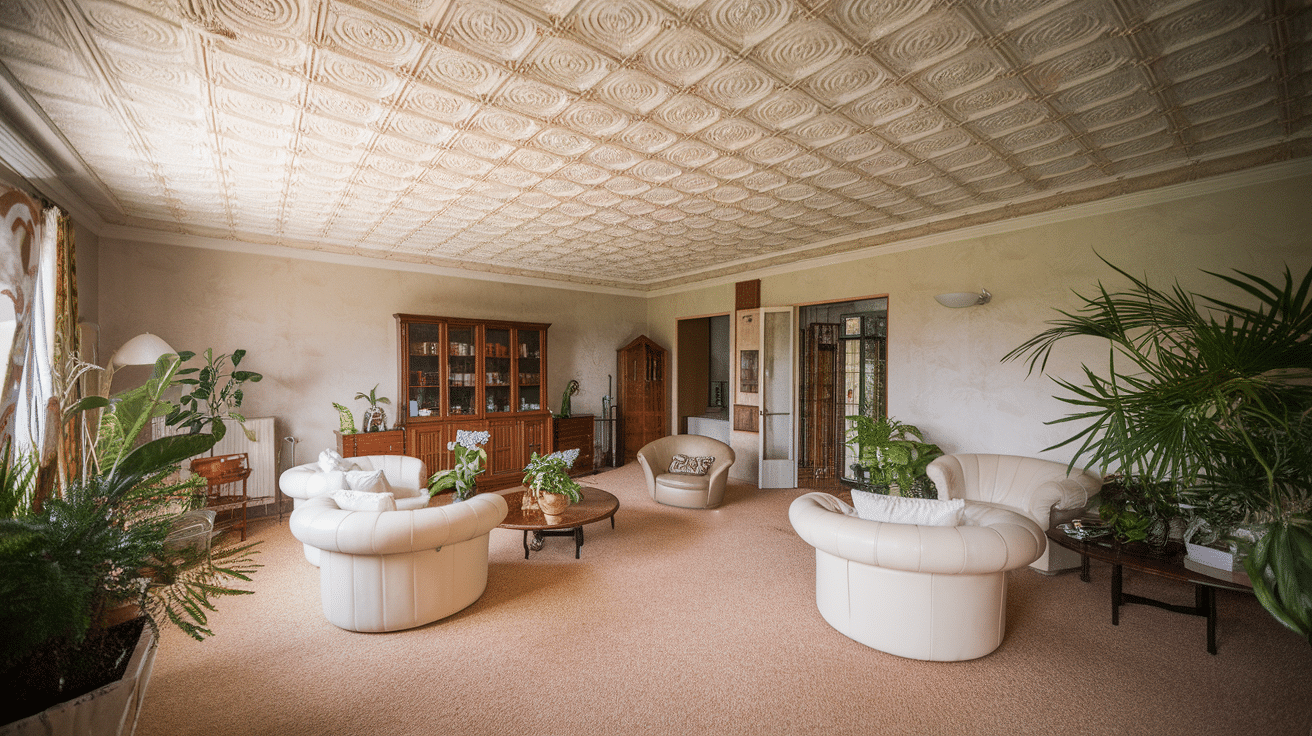
Artex is a special type of textured coating applied to ceilings. I like to describe it as “ceiling decoration with personality.”
You’ve probably seen Artex before, even if you didn’t know its name. It’s that swirly, bumpy finish on many home ceilings.
Artex became super popular in the 1970s and 1980s. It added character to plain ceilings and easily concealed imperfections.
Think of Artex as makeup for your ceiling. It covers flaws while adding style.
There isn’t just one Artex look. You can choose from several patterns:
Swirl
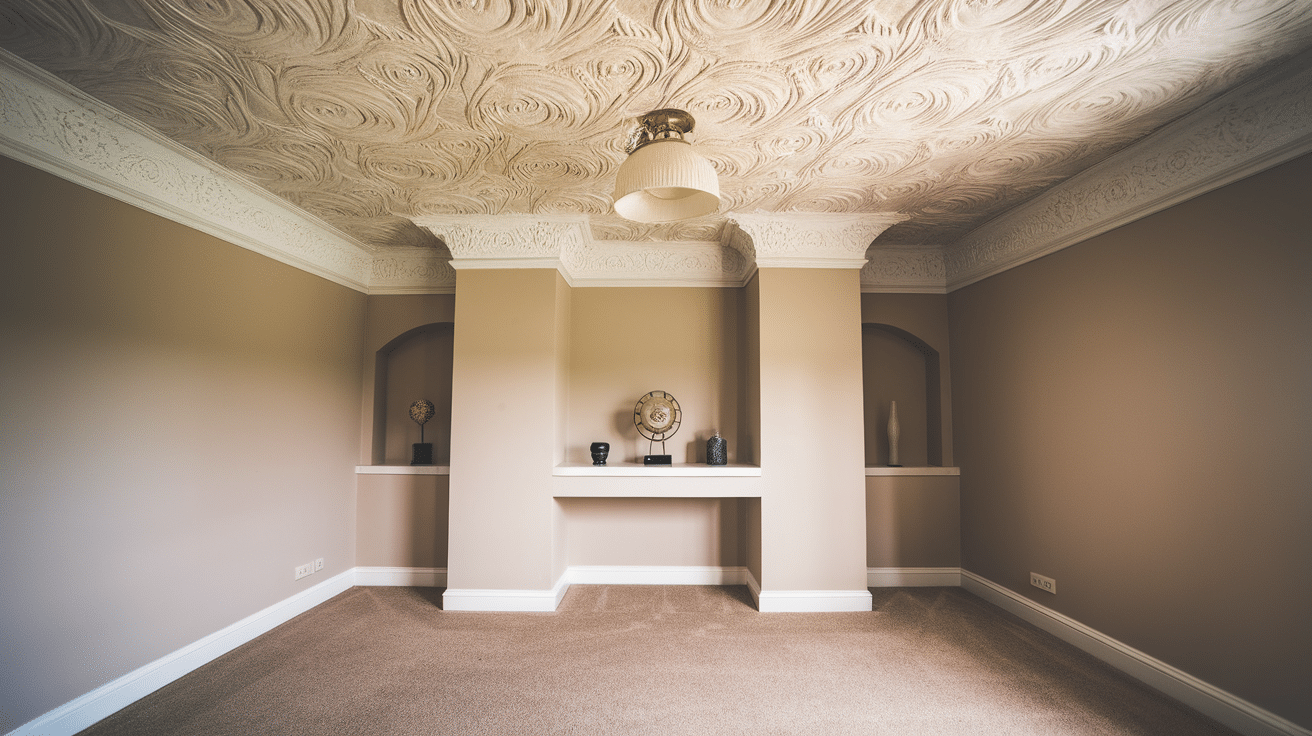
The swirl is the most common Artex pattern. It is made by applying overlapping curved lines in circles or arcs. It creates a soft, decorative look that’s easy to spot in older homes. The pattern can vary based on brush size and technique.
Stipple
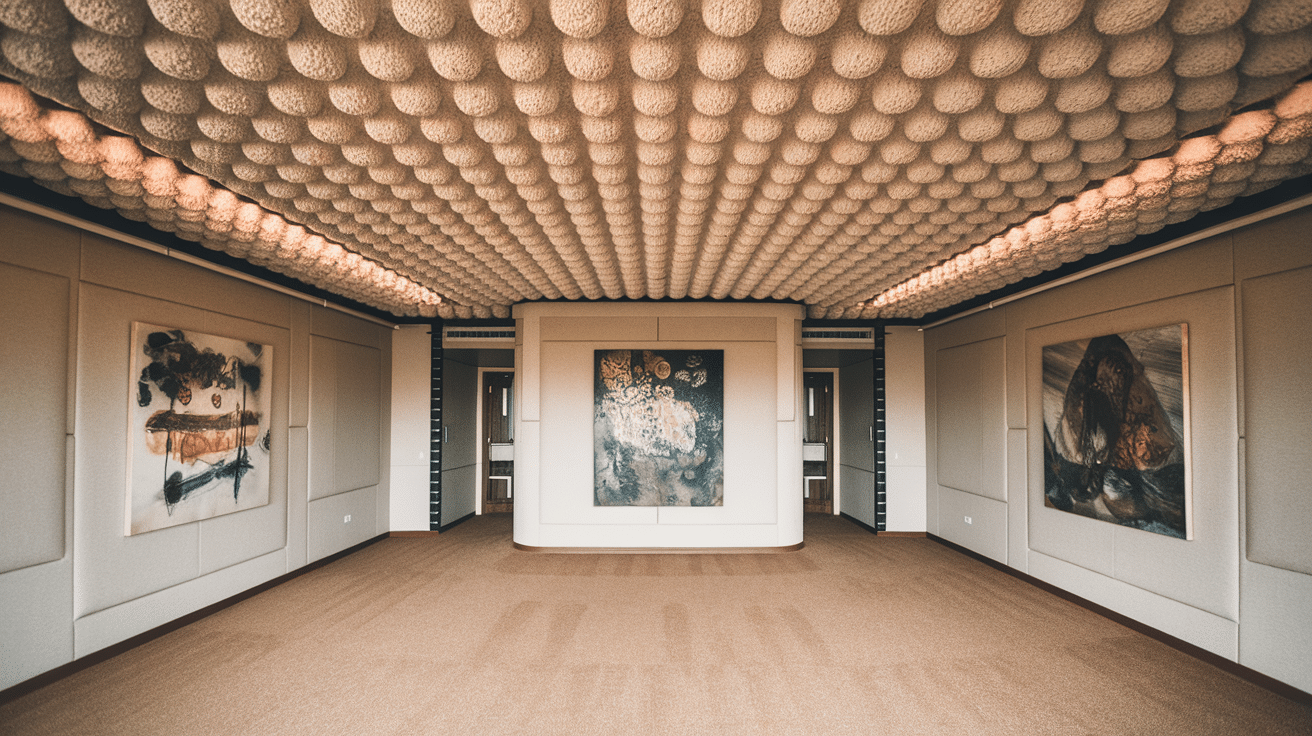
A stipple has a rough, dotted texture created by dabbing the surface with a brush or roller. It was often used to hide uneven ceilings or minor cracks. The finish looks raised and adds visual depth without sharp lines.
Broken Leather
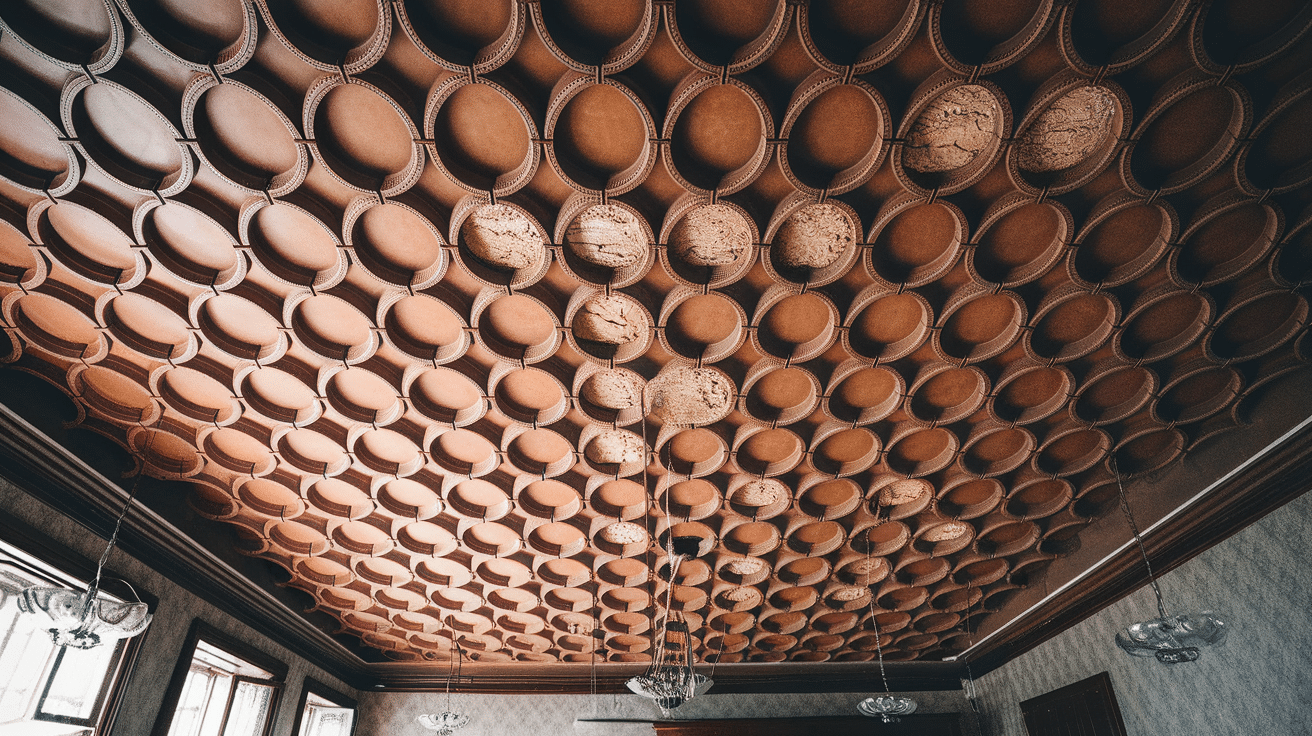
This pattern mimics the look of aged or creased leather. It’s done by pressing a plastic sheet or textured material into the wet Artex. The result is a random, natural texture that looks soft but is slightly rugged.
Fan Pattern
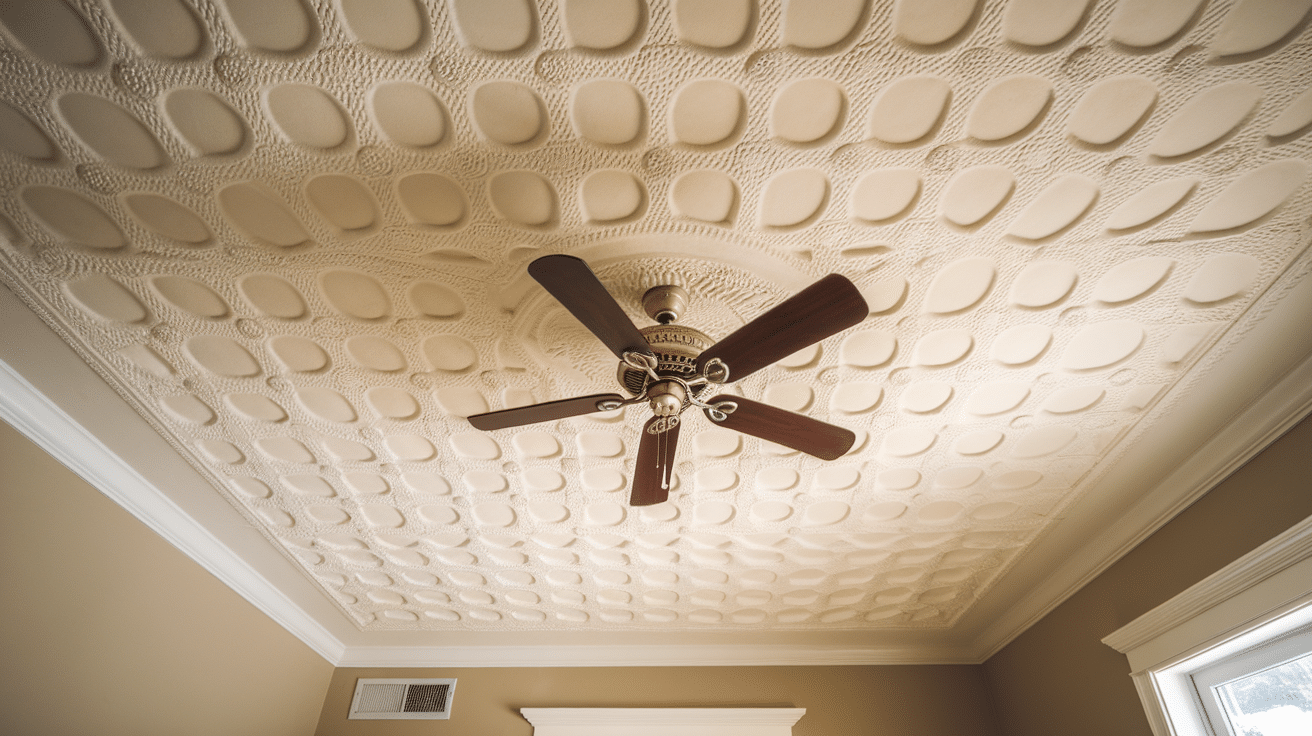
The fan pattern features repeating curved shapes that look like open fans. These are usually applied in rows or grids with a combing tool. It’s a tidy, eye-catching design that adds a bit of structure to the ceiling.
Scrolled
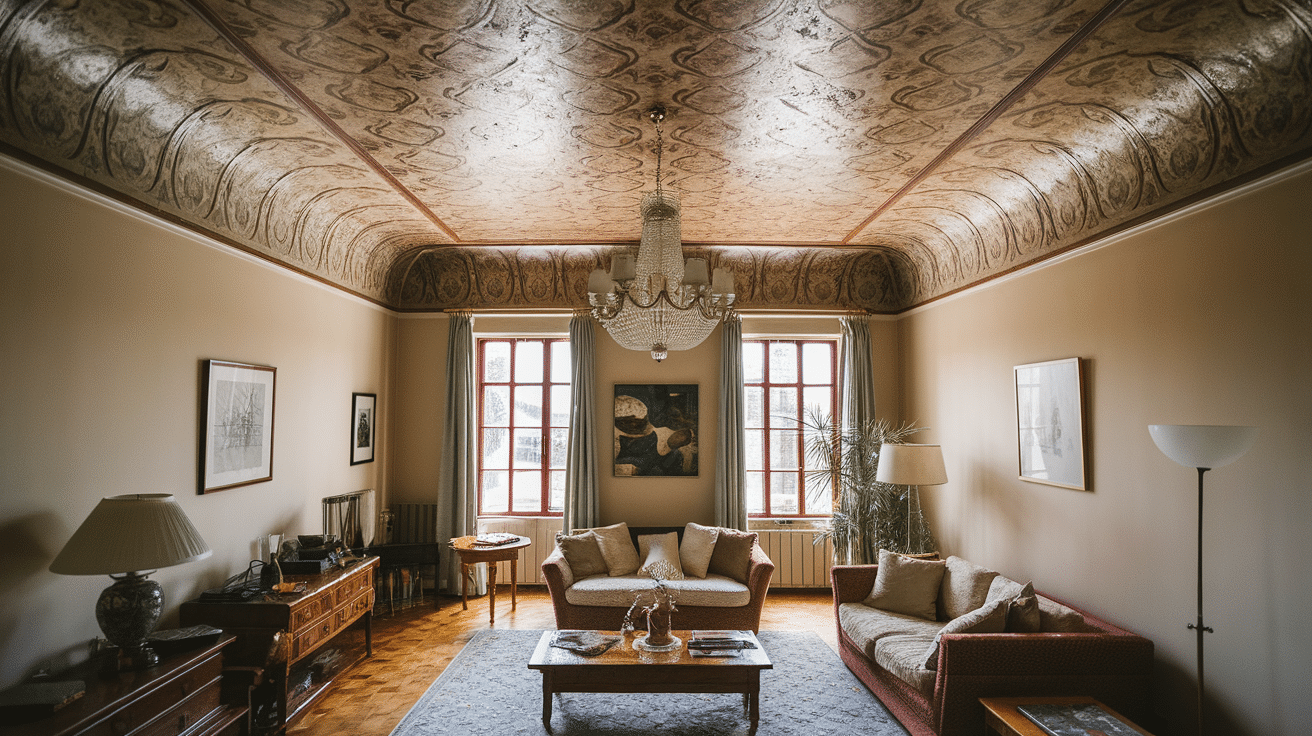
Scrolled artex has flowing, curved lines that twist in decorative loops, similar to scrollwork or vines. It’s a more detailed pattern that gives ceilings a formal, almost elegant feel. It works well in traditional-style homes.
The texture comes from a plaster-like mixture. Skilled workers apply it using special tools – often just a brush or roller with a technique.
Not all textured ceilings are Artex. Artex is actually a brand name that became so popular that people use it for any textured ceiling (like how people say “Kleenex” for all tissues).
Modern Artex products are different from older versions. Before the mid-1980s, some Artex contained asbestos – an important fact if you have an older home.
Why Was Artex Used?
Artex solved real problems for homeowners and builders. I’ve talked with many older contractors who used it regularly for good reasons.
You might wonder why so many homes have these textured ceilings. The answer is simple: practicality.
The biggest benefit was hiding flaws. When ceilings had cracks, uneven surfaces, or other problems, Artex covered them like magic—there was no need for expensive replastering or ceiling replacement.
Think about your own home. Have you ever tried to make a ceiling perfectly smooth? It’s incredibly difficult! Artex made this problem disappear.
The texture also added character to otherwise plain rooms. A flat ceiling can feel boring, but those swirls and patterns created visual interest.
For builders and homeowners on a budget, Artex made financial sense:
- Much cheaper than full plastering jobs
- Faster to apply than other options
- Requires less skill than advanced plastering techniques
- Lasted for decades with minimal maintenance
Contractors could finish more jobs in less time, homeowners saved money, and everyone got a ceiling that looked intentionally decorated rather than plain.
The timing mattered, too. Artex peaked in popularity during a housing boom when quick, affordable solutions were in high demand.
Truth About Artex and Asbestos
This part is important for your safety.
Artex products made before 1999 often contained asbestos. The manufacturers added it to strengthen the material and improve fire resistance.
You can’t tell if your Artex has asbestos just by looking at it.
The age of your home is your best clue:
- Home built before 1985? High chance of asbestos
- Home from 1985-1999? Moderate chance
- Home after 2000? Likely asbestos-free
Never, ever sand or scrape old Artex ceilings without testing first. I can’t stress this enough. When disturbed, asbestos fibers release into the air and can cause serious lung diseases.
Even small DIY projects on old Artex can be dangerous. Repairing a crack or installing a light fixture might expose you to harmful fibers.
What should you do if you suspect your ceiling contains asbestos?
- Leave it alone if it’s in good condition (undamaged Artex is generally safe)
- Get it professionally tested before any work
- Hire licensed asbestos professionals for removal
- Never attempt DIY removal
Testing costs about $50-150 per sample. It’s money well spent for peace of mind.
If removal is needed, only certified asbestos professionals should handle it. They have the proper equipment and follow strict safety protocols to protect your family.
Options for Dealing with An Artex Ceiling
You have several choices for your Artex ceiling. I’ll walk you through each option so you can decide what works best for your home and budget.
Leave It As-Is
The simplest option costs nothing. If your Artex ceiling is in good condition with no damage or flaking, leaving it alone is perfectly fine. Many homes still have their original Artex ceilings.
This works well when:
- The ceiling isn’t damaged
- You don’t mind the textured look
- You’re concerned about disturbing potential asbestos
You can easily freshen up an Artex ceiling with special roller-applied ceiling paint. Just be careful not to sand it first.
Skim Over It
Plastering over Artex creates a smooth, modern finish. A skilled plasterer applies a thin layer of plaster directly over the texture, filling in all the bumps and patterns.
This option:
- Preserves any asbestos safely underneath
- Gives you a fresh, flat ceiling
- Costs less than complete removal
- Usually takes 1-2 days to complete
The downside? It requires real skill. I’ve seen DIY skimming jobs go terribly wrong. Consider hiring a professional for this approach.
Remove It
Removal should only happen after proper testing. If your ceiling is asbestos-free or you hire licensed professionals, complete removal is possible.
This is the most disruptive and expensive option, but it gives you a completely fresh start.
Cover It
My favorite solution for most homeowners is covering the Artex with new material:
- Plasterboard (drywall) attached directly to the ceiling
- Decorative ceiling panels that click together
- Wooden tongue-and-groove planks for a cottage look
Covering systems create a small drop in ceiling height (about 1-2 inches) but offer a clean solution without disturbing the original material.
Which option makes the most sense for you? Consider your budget, how much disruption you can handle, and whether testing has confirmed asbestos presence.
Pros and Cons of Artex Ceilings
Let’s be honest about Artex. Like any home feature, it has clear advantages and disadvantages. I want you to understand both sides before making decisions about your ceiling.
Pros
Artex hides ceiling problems extremely well: Those swirls and textures mask uneven surfaces, small cracks, and imperfections that would be obvious on a flat ceiling.
I’ve seen Artex save homeowners thousands on repairs. When your ceiling has minor damage, texture can be your best friend.
Durability is another major benefit: A properly applied Artex ceiling can last decades without needing attention. The texture creates a hard, resilient surface that withstands the test of time.
Low maintenance is a real plus: Unlike flat ceilings that show every little mark, Artex rarely needs touching up. Dust and cobwebs are less visible on textured surfaces.
Cons
The biggest drawback is the dated appearance. Artex screams “1970s and 80s” to most people. If you’re going for a modern look, an Artex ceiling works against you.
When selling your home, Artex ceilings can actually lower your property value.
Painting and repairing Artex is tricky: The texture makes it hard to get even coverage with paint. If you need to fix a section, matching the original pattern is nearly impossible without professional help.
Safety concerns exist with older Artex: As we discussed earlier, the potential asbestos content in pre-1999 installations creates health risks when disturbed.
Cleaning textured ceilings is challenging: Dust collects in all those little grooves and peaks, making them much harder to clean than smooth surfaces.
Your decision should consider these factors alongside your budget, design preferences, and how long you plan to stay in your home.
Conclusion
Artex ceilings have a complex history in our homes. Understanding what you’re dealing with helps you make smart decisions about your ceiling.
Whether you choose to keep, cover, or remove your Artex ceiling depends on your specific situation. Consider your budget, design preferences, and safety concerns.
Remember these key points:
- Test for asbestos before disturbing any pre-1999 Artex
- Weigh all your options—sometimes, leaving it alone makes the most sense
- Hire professionals for any major ceiling work
- Consider modern alternatives if you’re updating your home
You look at your ceiling every day. Taking the time to make the right decision will pay off in safety and satisfaction.
The bottom line? Artex served a purpose in its time. Today, you have more options, but you need to handle existing Artex with care and knowledge.
I hope this guide helps you feel confident about your ceiling choices. With the right approach, you can have a ceiling that’s safe, attractive, and right for your home.
Frequently Asked Questions
How Much Does It Cost to Remove Artex?
Professional Artex removal typically costs $15-30 per square foot, depending on asbestos content. A standard 12×12 room might cost $2,000-4,500 for complete removal. Covering or skimming is usually 30-50% cheaper.
Can I Paint Over Artex?
Yes, you can paint over Artex using a thick roller and specialized ceiling paint. Never sand it first if there’s any chance of asbestos. Multiple thin coats work better than one thick coat.
How Do I Know if My Artex Contains Asbestos?
You can’t tell by looking. The only reliable method is professional testing. Send a small sample to an accredited lab or hire a local asbestos surveyor to test it for you.
Is Artex Dangerous if Left Alone?
Undamaged, undisturbed Artex is generally safe, even if it contains asbestos. The fibers only become hazardous when released into the air through cutting, drilling, or sanding.
Do People Still Use Artex Today?
Modern versions of Artex (without asbestos) are still available, but they’re much less popular than in previous decades. Most new homes and renovations now favor smooth ceilings.

